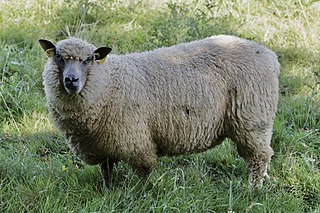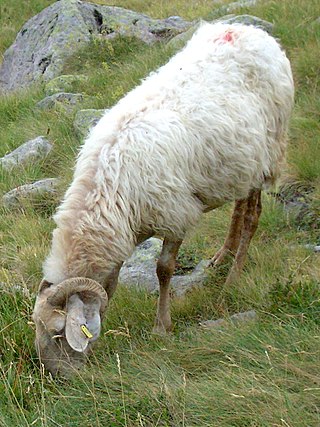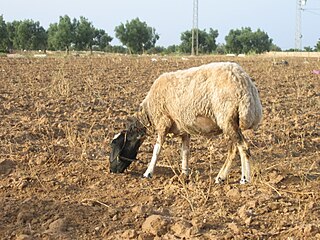Related Research Articles

The Maine-Anjou is a French breed of domestic cattle, raised mainly in the Pays de la Loire region in north-western France. It was created in the nineteenth century in the historic province of Maine by cross-breeding the local Mancelle dairy cattle with Durham stock from Britain, and was at first called the Durham-Mancelle. In France it has been known since 2004 as the Rouge des Prés, but the Maine-Anjou name continues to be used elsewhere. It was formerly a dual-purpose animal, raised both for meat and for milk, but is now principally a beef breed.

The Aubrac is a French breed of domestic beef cattle. It originates on the Plateau de l'Aubrac in the Massif Central in central southern France, from which it also takes its name. It has a wheat-coloured coat and dark hooves, switch, muzzle and eyes.

The Landais is a critically-endangered French breed of small horse or pony. It originated in the marshy plains and woodlands of the département of the Landes, in the Nouvelle-Aquitaine region of south-western France, but is more often reared in the département of Pyrénées-Atlantiques, particularly in the arrondissement of Pau. Due to influences from Arab and Welsh blood, it shows more similarity to Oriental horses than to other Celtic breeds. It is used for riding and driving, and is a good trotter.

The Lourdaise is an endangered French breed of domestic cattle. It is named for the town of Lourdes, in the Hautes-Pyrénées département of the region of Occitanie, and originated in the surrounding country, particularly in the cantons of Argelès, Bagnères-de-Bigorre and Ossun. It was formerly a triple-purpose breed, kept for its milk, for its meat and for draught work. It was widely distributed in the Pyrénées of south-western France. It came close to extinction in the 1980s, but has since recovered following conservation efforts. It remains critically endangered.

The Armoricaine or Armorican is an endangered French breed of domestic cattle. It originated in Brittany in the nineteenth century. It has a red coat with white markings, and has short horns.

The Bleu du Maine is a French breed of domestic sheep. It originated in the historic region of Maine, and is distributed mainly in the départements of Maine-et-Loire, the Mayenne and the Sarthe in the Pays de la Loire in western France.

The Rouge de l'Ouest is breed of domestic sheep originating in France. The breed's name, which literally translates from French as "Red of the West", refers to its region of origin and its unique pinkish face and legs. It was developed in the Maine et Loire department of France, through crossing local landrace sheep with Wensleydales and Bluefaced Leicesters. The French registry was established in 1968, and the U.K. registry was in 1986.

The Provence Donkey, French: Âne de Provence, is a breed of domestic donkey from Provence, in south-eastern France. It is now distributed through much of central and south-east France, with the highest concentration in Provence and the Rhône-Alpes region. For hundreds of years the Provence donkey was used by transhumant shepherds of the area as a pack animal in the seasonal movement of flocks of sheep between their summer pastures on the high Alps of Haute-Provence and the Dauphiné and their winter grounds in Basse-Provence.

The Appenninica is a modern breed of sheep from the central Apennine mountains of Italy. It is raised principally in Tuscany and Umbria, but also in Abruzzo, Emilia–Romagna, Lazio, the Marche and Campania. The breed was created in the 1970s by cross-breeding and subsequent selection of local breeds such as the Bariscianese, the Casentinese, the Chietina Varzese, the Pagliarola, the Perugina del piano, the Pomarancina, the Senese delle Creti and the Vissana with Bergamasca rams and with the French Ile-de-France and Berrichon du Cher, with the aim of increasing the meat yield. The breed was recognised in 1980 and a herdbook established in 1981. Although this is a medium-coarse wool breed, it is raised primarily for meat.
The British Milksheep is a robust, dual-purpose sheep commonly known for its milking characteristics.

The Charmoise is a French breed of domestic sheep. It was created in the early nineteenth century by Édouard Malingié, by cross-breeding of Romney stock imported from the United Kingdom with local breeds including the Berrichon du Cher, Merino, Solognote and Tourangelle. It is reared for both meat and wool. Breed numbers fell from a peak of approximately 650000 in the 1960s to about 122000 in 1983, to approximately 21000 in 2001, and further to 8100 in 2014.

The Brigasca, French: Brigasque, is a breed of sheep from Liguria in north-west Italy and the département of Alpes-Maritimes in south-eastern France. It takes its name from the town of La Brigue, which was until 1947 in the Italian province of Cuneo. The Brigasca is raised in the provinces of Imperia and Savona in Italy, and neighbouring areas in France. It appears to have origins in common with the Frabosana and Delle Langhe breeds. It is one of the forty-two autochthonous local sheep breeds of limited distribution for which a herdbook is kept by the Associazione Nazionale della Pastorizia, the Italian national association of sheep-breeders.
The Garessina or Muma is a breed of small sheep from the Garessina, the area surrounding Garessio in the province of Cuneo, in Piemonte in north-west Italy. It is raised principally in the valleys of the Tanaro, its affluent the Negrone, and the Casotto; it is not raised commercially, but kept as a family sheep. It has been influenced by Spanish Merino and French Alpine breeds. The wool is of fine quality. The Garessina is one of the forty-two autochthonous local sheep breeds of limited distribution for which a herdbook is kept by the Associazione Nazionale della Pastorizia, the Italian national association of sheep-breeders.
The Trimeticcia di Segezia is a modern breed of domestic sheep from Puglia in southern Italy. It is named for the town of Segezia, a frazione of Foggia, where it was created at the Istituto Sperimentale per la Zootecnia, an experimental breeding station of the Ministero delle Politiche Agricole, Alimentari e Forestali, the Italian ministry of agriculture. "Trimeticcia" means "three-way hybrid": the breed was created by cross-breeding Gentile di Puglia ewes with French Île-de-France rams, and then crossing the resultant hybrid with Württemberger rams; the resulting stock was selectively bred for adaptation to the climate and conditions of the area. The range of the breed is principally the plain of the Tavoliere delle Puglie, but extends also into Molise. The Trimeticcia di Segezia is one of the forty-two autochthonous local sheep breeds of limited distribution for which a herd-book is kept by the Associazione Nazionale della Pastorizia, the Italian national association of sheep-breeders.
The Merinizzata Italiana is a breed of domestic sheep from southern Italy. It is a modern breed, created in the first half of the twentieth century or in recent decades by cross-breeding of indigenous Gentile di Puglia and Sopravissana stock with imported Merino breeds such as the French Berrichon du Cher and Île-de-France, and the German Merinolandschaf. The aim was to produce a good meat breed without sacrificing wool quality. The Merinizzata Italiana is raised mostly in Abruzzo, mainly in the provinces of L'Aquila and Teramo, with small numbers in neighbouring regions.

The Bretonne Pie Noir is breed of small dairy cattle from Brittany in north-western France. It originates from Cornouaille and the Pays de Vannes in the départements of Finistère and Morbihan. Due to its small size, modest requirements, good productivity and ability to exploit poor and marginal terrain, it was well suited to traditional Breton agriculture. A herdbook was established in 1886. The breed was in the past numerous; at the beginning of the twentieth century there were about 500,000. Numbers fell drastically during that century, and in 1976, when about 15,000 remained, a breed conservation plan was begun, the first such for any breed of cattle.

The Pyrenean, French: Âne des Pyrénées, is a French breed of domestic donkey. It is distributed in a large area of south-western France, covering the whole of the regions of Aquitaine, Midi Pyrénées and Languedoc Roussillon. The largest concentration is in Aquitaine, which is a large part of the historic region of Gascony. The Pyrenean donkey breed unites two quite different types: the short and powerful Gascon type, and the taller and more elegant Catalan type, which is the French population of the Catalan donkey breed, approximately 20% of the total number of which is in the Roussillon.

The Rouge du Roussillon is an endangered breed of sheep from southern France. It is primarily raised in the French Mediterranean countryside for lamb meat.

The Tunisian Barbarin is a Tunisian breed of fat-tailed sheep. It is distributed throughout Tunisia, and on both sides of the Tunisian border with Algeria, on the Algerian side particularly in the area of Oued Souf. Related to the Awassi

The Australian Merino is an Australian breed or group of breeds of sheep, forming a significant part of the Merino group of breeds. Its origins lie in Merino sheep imported to Australia from South Africa in about 1796. By about 1830 there were almost two million Merinos in the country.
References
- 1 2 3 4 5 6 7 8 9 10 11 12 13 14 15 16 17 18 19 20 21 22 23 24 25 26 27 28 29 30 31 32 33 34 35 36 37 38 39 40 41 42 43 44 45 46 47 48 49 50 51 52 Breed data sheet: France / Sheep. Domestic Animal Diversity Information System of the Food and Agriculture Organization of the United Nations. Accessed July 2021.
- 1 2 3 4 5 6 7 8 9 10 11 12 13 14 15 16 17 18 19 20 21 22 23 24 25 26 27 28 29 30 31 32 33 Barbara Rischkowsky, Dafydd Pilling (editors) (2007). List of breeds documented in the Global Databank for Animal Genetic Resources, annex to The State of the World's Animal Genetic Resources for Food and Agriculture. Rome: Commission on Genetic Resources for Food and Agriculture, Food and Agriculture Organization of the United Nations. ISBN 9789251057629. Archived 23 June 2020.